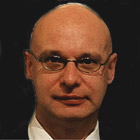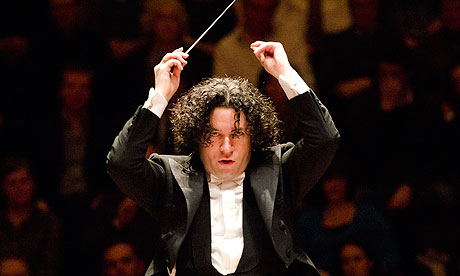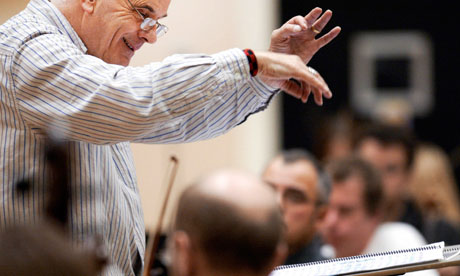To step back for a moment, I began this project with bravado, partly as an intellectual game but also as a real attempt to clarify — for myself, as much as for anyone else — what exactly about the master composers makes them so astonishing. However preposterous the exercise may seem, when I found myself debating whether to push Brahms or Haydn off the list to make a place for Bartok or Monteverdi, it made me think hard about their achievements and greatness.
Ah, greatness. Early on I received a friendly challenge from a reader (“Scott”) who questioned the whole notion of greatness in music. He cited the title essay in “Listen to This,” a collection of astute, lively writings by Alex Ross, the music critic for The New Yorker and my good friend, which was published last year (Farrar, Straus & Giroux). In this essay he argues that the very term “classical music” makes this vibrant art form seem dead. Indeed, as he writes, “greatness” and “seriousness” are not classical music’s defining characteristics; it can also “be stupid, vulgar and insane.”
All true. Yet what came through in the comments from readers and, I hope, my articles and videos is that for most of us these composers are not monumental idols but living, compelling presences. Just as we organize our lives by keeping those we love in a network of support, we do something similar with the composers we rely on.
I was moved by how many readers could not wait to share their lists of favorite composers, whom, naturally, they also considered the greats. Even many of those who dismissed the exercise jumped right in: “This is absurd, of course. But here’s my list. And don’t you dare leave out Mahler.” Or Berg. Or Ligeti. Or, from one Baroque music enthusiast, Albinoni!
As a longtime champion of contemporary music, I was gratified to receive so many objections to my decision to eliminate living composers from consideration. Still, for me there was no other way. We are too close to living composers to have perspective. Besides, assessing greatness is the last thing on your mind when you are listening to an involving, exciting or baffling new piece.
So humbled by the discerning music lovers who wrote in, I now offer my own list. And remember: my editors gave the go-ahead for this project on condition that I go all the way and rank my 10 in order.
My top spot goes to Bach, for his matchless combination of masterly musical engineering (as one reader put it) and profound expressivity. Since writing about Bach in the first article of this series I have been thinking more about the perception that he was considered old-fashioned in his day. Haydn was 18 when Bach died, in 1750, and Classicism was stirring. Bach was surely aware of the new trends. Yet he reacted by digging deeper into his way of doing things. In his austerely beautiful “Art of Fugue,” left incomplete at his death, Bach reduced complex counterpoint to its bare essentials, not even indicating the instrument (or instruments) for which these works were composed.
On his own terms he could be plenty modern. Though Bach never wrote an opera, he demonstrated visceral flair for drama in his sacred choral works, as in the crowd scenes in the Passions where people cry out with chilling vehemence for Jesus to be crucified. In keyboard works like the Chromatic Fantasy and Fugue, Bach anticipated the rhapsodic Romantic fervor of Liszt, even Rachmaninoff. And as I tried to show in the first video for this project, through his chorales alone Bach explored the far reaches of tonal harmony.
The obvious candidates for the second and third slots are Mozart and Beethoven. If you were to compare just Mozart’s orchestral and instrumental music to Beethoven’s, that would be a pretty even match. But Mozart had a whole second career as a path-breaking opera composer. Such incredible range should give him the edge.
Still, I’m going with Beethoven for the second slot. Beethoven’s technique was not as facile as Mozart’s. He struggled to compose, and you can sometimes hear that struggle in the music. But however hard wrought, Beethoven’s works are so audacious and indestructible that they survive even poor performances.
I had an epiphany about Beethoven during the early 1980s when I heard the composer Leon Kirchner conduct the Harvard Chamber Orchestra. He began with a Piston symphony, a fresh, inventive Neo-Classical piece from the 1950s. “La Mer” by Debussy came next, and Kirchner, who had studied with Schoenberg and had a Germanic orientation, brought weighty, Wagnerian intensity to this landmark score, completed in 1905. The Debussy came across as more modern than the Piston.
After intermission Peter Serkin joined Kirchner for a performance of Beethoven’s Fourth Piano Concerto that brought out the mysticism, poetic reverie and wildness of the music. The Beethoven sounded like the most radical work in the program by far: unfathomable and amazing. I’m giving Beethoven the second slot, and Mozart No. 3.
Four? Schubert. You have to love the guy, who died at 31, ill, impoverished and neglected except by a circle of friends who were in awe of his genius. For his hundreds of songs alone — including the haunting cycle “Winterreise,” which will never release its tenacious hold on singers and audiences — Schubert is central to our concert life. The baritone Sanford Sylvan once told me that hearing the superb pianist Stephen Drury give searching accounts of the three late Schubert sonatas on a single program was one of the most transcendent musical experiences of his life. Schubert’s first few symphonies may be works in progress. But the “Unfinished” and especially the Ninth Symphony are astonishing. The Ninth paves the way for Bruckner and prefigures Mahler.
The Greatest
Published: January 21, 2011
(Page 2 of 2)
Debussy, who after hundreds of years of pulsating Germanic music proved that there could be tension in timelessness, is my No. 5. With his pioneering harmonic language, the sensual beauty of his sound and his uncanny, Freudian instincts for tapping the unconscious, Debussy was the bridge over which music passed into the tumultuous 20th century.

The Top 10 Composers
Anthony Tommasini explores the qualities that make a classical composer great, maybe even the best of all time.
Blog
ArtsBeat
The latest on the arts, coverage of live events, critical reviews, multimedia extravaganzas and much more. Join the discussion.
Readers' Comments
Share your thoughts.
One who later walked that bridge was Stravinsky, my No. 6. During the years when “The Firebird” and “The Rite of Spring” were shaking up Paris, Stravinsky was swapping ideas with his friend Debussy, who was 20 years older. Yet Stravinsky was still around in the 1960s, writing serial works that set the field of contemporary music abuzz. One morning in 1971 I arrived at the door of the music building at Yale, on which someone had posted an index card with this simple news: “Igor Stravinsky died today.” It felt as if the floor had dropped out from under the musical world I inhabited. Stravinsky had been like a Beethoven among us.
I’m running out of slots. In some ways, as I wrote to one reader, either a list of 5 or a list of 20 would have been much easier. By keeping it to 10, you are forced to look for reasons to push out, say, Handel or Shostakovich to make a place for someone else.
Some musicians I respect have no trouble finding shortcomings in Brahms. He did sometimes become entangled in an attempt to extend the Classical heritage while simultaneously taking progressive strides into new territory. But at his best (the symphonies, the piano concertos, the violin concerto, the chamber works with piano, the solo piano pieces, especially the late intermezzos and capriccios that point the way to Schoenberg) Brahms has the thrilling grandeur and strangeness of Beethoven. Brahms is my No. 7.
In an earlier installment of this series I tried to weasel out of picking Romantic composers other than Brahms by arguing that the era fostered originality and personal expression above all. To a genius like Chopin, having a distinctive voice and giving vent to his inspirations were more important than achieving some level of quantifiable greatness.
But the dynamic duo of 19th-century opera, Verdi and Wagner, aimed high. As I already let slip, they both make my list. That a new production of a Verdi opera, like Willy Decker’s spare, boldly reimagined staging of “La Traviata” at the Metropolitan Opera, can provoke such heated passions among audiences is testimony to the enduring richness of Verdi’s works. A production of Wagner’s “Ring” cycle has become the entry card for any opera company that wants to be considered big time. The last 20 minutes of “Die Walküre” may be the most sadly beautiful music ever written.
But who ranks higher? They may be tied as composers but not as people. Though Verdi had an ornery side, he was a decent man, an Italian patriot and the founder of a retirement home for musicians still in operation in Milan. Wagner was an anti-Semitic, egomaniacal jerk who transcended himself in his art. So Verdi is No. 8 and Wagner No. 9.
One slot left. May Haydn forgive me, but one of the Vienna Four just had to go, and Haydn’s great legacy was carried out by his friend Mozart, his student Beethoven and the entire Classical movement. My apologies to Mahler devotees, so impressively committed to this visionary composer. Would that I could include my beloved Puccini.
I was heartened by the hundreds of readers who championed 20th-century composers like Ligeti, Messiaen, Shostakovich, Ives, Schoenberg, Prokofiev and Copland, all of whom are central to my musical life. Then there is Berg, who wrote arguably the two greatest operas of the 20th century. His Violin Concerto, as I explained in my first video, would make my list of top 10 pieces. I was disappointed that an insignificant number of readers made a case for Britten. I have some advocacy work to do.
I received the most forceful challenges from readers who thought that pre-Bach composers simply had to be included, especially Monteverdi. Though Monteverdi did not invent opera, he took one look at what was going in Florence around 1600 and figured out how this opera thing should really be done. In 1607 he wrote “Orfeo,” the first great opera. His books of madrigals brought the art of combining words and music to new heights. The Monteverdi contingent is probably right.
But forced to pick only one more composer, I’m going with Bartok. In an earlier piece I made my case for Bartok, as an ethnomusicologist whose work has empowered generations of subsequent composers to incorporate folk music and classical traditions from whatever culture into their works, and as a formidable modernist who in the face of Schoenberg’s breathtaking formulations showed another way, forging a language that was an amalgam of tonality, unorthodox scales and atonal wanderings.
So that’s my list.
And now, in an act of contrition, I am beginning a personal project to listen nonstop to recordings of Britten, Haydn, Chopin, Monteverdi, Ligeti and those composers whom I could not squeeze in but whose music carries me through my days.
















 Peter Maxwell Davies rehearsing with the BBC Philharmonic. Photograph: Christopher Thomond
Peter Maxwell Davies rehearsing with the BBC Philharmonic. Photograph: Christopher Thomond 



